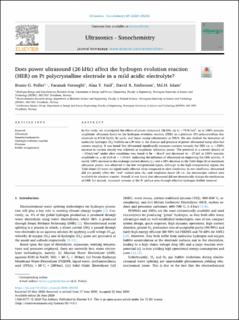| dc.contributor.author | Pollet, Bruno | |
| dc.contributor.author | Foroughi, Faranak | |
| dc.contributor.author | Faid, Alaa | |
| dc.contributor.author | Emberson, David | |
| dc.contributor.author | Islam, Md Hujjatul | |
| dc.date.accessioned | 2024-02-29T09:11:45Z | |
| dc.date.available | 2024-02-29T09:11:45Z | |
| dc.date.created | 2020-08-27T18:08:26Z | |
| dc.date.issued | 2020 | |
| dc.identifier.citation | Ultrasonics sonochemistry. 2020, 69 . | en_US |
| dc.identifier.issn | 1350-4177 | |
| dc.identifier.uri | https://hdl.handle.net/11250/3120420 | |
| dc.description.abstract | In this study, we investigated the effects of power ultrasound (26 kHz, up to ∼75 W/cm2, up to 100% acoustic amplitude, ultrasonic horn) on the hydrogen evolution reaction (HER) on a platinum (Pt) polycrystalline disc electrode in 0.5 M H2SO4 by cyclic and linear sweep voltammetry at 298 K. We also studied the formation of molecular hydrogen (H2) bubbles on a Pt wire in the absence and presence of power ultrasound using ultra-fast camera imaging. It was found that ultrasound significantly increases currents towards the HER i.e. a ∼250% increase in current density was achieved at maximum ultrasonic power. The potential at a current density of −10 mA/cm2 under silent conditions was found to be −46 mV and decreased to −27 mV at 100% acoustic amplitude i.e. a ΔE shift of ∼+20 mV, indicating the influence of ultrasound on improving the HER activity. A nearly 100% increase in the exchange current density (jo) and a 30% decrease in the Tafel slope (b) at maximum ultrasonic power, was observed in the low overpotential region, although in the high overpotential region, the Tafel slopes (b) were not significantly affected when compared to silent conditions. In our conditions, ultrasound did not greatly affect the “real” surface area (Ar) and roughness factor (R) i.e. the microscopic surface area available for electron transfer. Overall, it was found that ultrasound did not dramatically change the mechanism of HER but instead, increased currents at the Pt surface area through effective hydrogen bubble removal. | en_US |
| dc.language.iso | eng | en_US |
| dc.publisher | Elsevier | en_US |
| dc.rights | Navngivelse 4.0 Internasjonal | * |
| dc.rights.uri | http://creativecommons.org/licenses/by/4.0/deed.no | * |
| dc.title | Does power ultrasound (26 kHz) affect the hydrogen evolution reaction(HER) on Pt polycrystalline electrode in a mild acidic electrolyte? | en_US |
| dc.title.alternative | Does power ultrasound (26 kHz) affect the hydrogen evolution reaction(HER) on Pt polycrystalline electrode in a mild acidic electrolyte? | en_US |
| dc.type | Peer reviewed | en_US |
| dc.type | Journal article | en_US |
| dc.description.version | publishedVersion | en_US |
| dc.source.pagenumber | 9 | en_US |
| dc.source.volume | 69 | en_US |
| dc.source.journal | Ultrasonics sonochemistry | en_US |
| dc.identifier.doi | 10.1016/j.ultsonch.2020.105238 | |
| dc.identifier.cristin | 1825625 | |
| cristin.ispublished | true | |
| cristin.fulltext | original | |
| cristin.qualitycode | 1 | |

